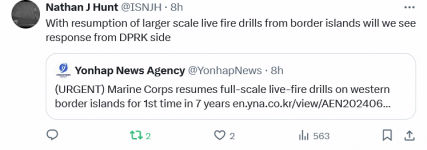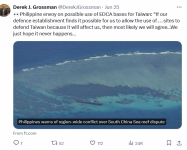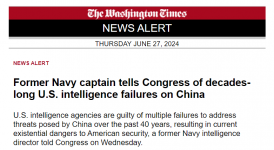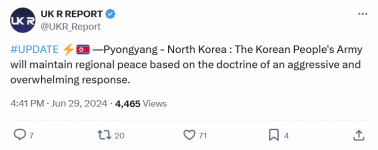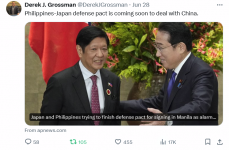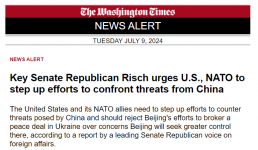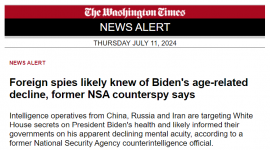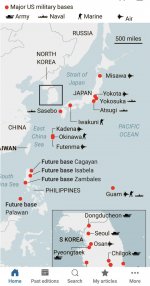You are using an out of date browser. It may not display this or other websites correctly.
You should upgrade or use an alternative browser.
You should upgrade or use an alternative browser.
ALERT The Winds of War Blow in Korea and The Far East
- Thread starter northern watch
- Start date
jward
passin' thru
Marine Corps resumes full-scale live-fire drills on border islands for 1st time in 7 years
By Chae Yun-hwan
SEOUL, June 26 (Yonhap) -- The Marine Corps on Wednesday resumed a full-scale live-fire exercise on islands near the tensely guarded western inter-Korean maritime border for the first time in seven years.
The resumption came as South Korea fully suspended the 2018 inter-Korean tension reduction accord in early June that calls for banning live-fire drills in waters near the Northern Limit Line (NLL) -- the de facto inter-Korean maritime boundary.
The drills, involving various artillery pieces, took place on the islands of Yeonpyeong and Baengnyeong in the Yellow Sea, just south of the NLL.
The preplanned exercise came amid heightened tensions after the North's launch of a ballistic missile that exploded in midair earlier in the day, according to the South Korean military.
The Marine Corps said its troops fired more than 290 live rounds into waters off the islands during the drills, which involved K9 howitzers, Chunmoo multiple rocket launcher systems and Spike anti-tank missiles.
The Marine Corps last held a full-scale live-fire exercise on the islands in 2017, a year before the two Koreas signed the military accord that set up a maritime buffer zone around the NLL to ban such drills, among other measures, to reduce cross-border tensions.
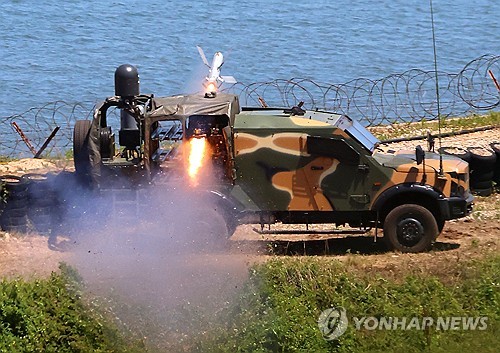
Marines on the northwestern border island of Yeonpyeong fire a Spike anti-tank missile into waters off the island on June 26, 2024. (Yonhap)
yunhwanchae@yna.co.kr
(END)

Marine Corps resumes full-scale live-fire drills on border islands for 1st time in 7 years | Yonhap News Agency
By Chae Yun-hwan SEOUL, June 26 (Yonhap) -- The Marine Corps on Wednesday resumed a full...
jward
passin' thru
(3rd LD) N.K. missile launch ends in mid-air explosion amid possibility of hypersonic missile test
(ATTN: CHANGES headline, lead; UPDATES throughout with details; ADDS photo)
By Chae Yun-hwan
SEOUL, June 26 (Yonhap) -- North Korea launched a ballistic missile toward the East Sea on Wednesday, but the missile exploded in the air, South Korea's military said, amid a possibility that the North could have test-fired a hypersonic missile.
The Joint Chiefs of Staff (JCS) said the missile was launched from an area in or around Pyongyang at around 5:30 a.m., and the intelligence authorities of South Korea and the United States are conducting a detailed analysis.
A military source told Yonhap News Agency that the North appears to have test-fired a hypersonic missile, but the test is believed to have ended in failure after the missile flew some 250 kilometers.
A JCS official later told reporters on condition of anonymity that the military is considering the possibility of a hypersonic missile launch, noting that the missile exploded in midair over waters off the North's east coast.
Smoke appeared to emanate from the missile more than previous launches, the official said, raising the possibility of combustion issues. The official added the missile could possibly be powered by solid propellants.
Solid-fuel missiles are considered to be harder to detect ahead of a launch compared with liquid-fuel ones as they require less preparation procedures, such as the injection of fuel.
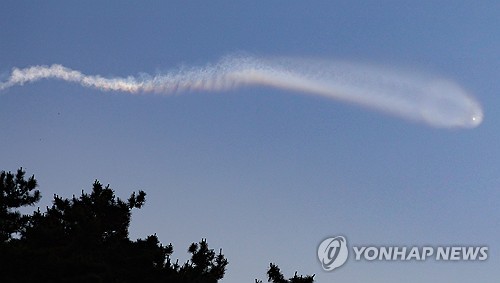
A trail of what appears to be a North Korean missile launch is seen near South Korea's northwestern border island of Yeonpyeong in the Yellow Sea on June 26, 2024. (Yonhap)
The launch came after the North slammed the arrival in South Korea of the U.S. aircraft carrier USS Theodore Roosevelt and warned of taking "overwhelming and new" deterrence measures against what it called a "provocative" act.
The aircraft carrier arrived in Busan, 320 kilometers southeast of Seoul, on Saturday ahead of a trilateral exercise with South Korea and Japan.
President Yoon Suk Yeol boarded the aircraft carrier Tuesday, saying the visit symbolized the "firm" U.S. security commitment to South Korea and that trilateral cooperation among South Korea, the U.S. and Japan will become another "powerful" deterrent.
The missile launch also came after the North signed a comprehensive strategic cooperation treaty with Russia during a summit last week between Russian President Vladimir Putin and North Korean leader Kim Jong-un, which includes a pledge for the two countries to come to each other's aid if attacked.
Hypersonic missiles are on the list of sophisticated weapons North Korean leader Kim Jong-un vowed to develop during a key party congress in 2021.
Such missiles travel at a speed of at least Mach 5 -- five times the speed of sound -- and are designed to be maneuverable on unpredictable flight paths and fly at low altitudes.
In April, the North claimed to have successfully test-fired a new intermediate-range ballistic missile tipped with a hypersonic warhead.
Wednesday's launch also took place hours after the North sent trash-carrying balloons to the South on Tuesday night for the second straight day.
Since late last month, North Korea is estimated to have launched more than 2,000 of such balloons in a tit-for-tat move against anti-Pyongyang propaganda leaflets sent by North Korean defectors and activists in the South.
The North last launched multiple short-range ballistic missiles into the East Sea on May 30.

A trail of what appears to be a North Korean missile launch is seen from South Korea's northwestern border island of Baengnyeong in the Yellow Sea on June 26, 2024, in this photo provided by an individual on the island. (PHOTO NOT FOR SALE) (Yonhap)
yunhwanchae@yna.co.kr
(END)

(3rd LD) N.K. missile launch ends in mid-air explosion amid possibility of hypersonic missile test | Yonhap News Agency
(ATTN: CHANGES headline, lead; UPDATES throughout with details; ADDS photo)By Chae Yun-hwa...
jward
passin' thru
Indo-Pacific News - Geo-Politics & Defense
@IndoPac_Info
#China Conducts Landing Ship Drills as Tensions Rise in #SouthChinaSea
China's navy is conducting amphibious drills in the South China Sea as tensions rise over control of the Philippine exclusive economic zone, over five hundred nautical miles away from the Chinese mainland.
Chinese state television broadcaster CCTV reports that three landing ships - Danxiashan, Laotieshan and Lushan - carried out a four-day combat drill at an undisclosed location in the South China Sea.
The drills focused on search and rescue, live fire, damage control, ship-to-ship mooring, smokescreens, and anti-drone air defense operations - a modern addition reflecting the recent evolution of unmanned aviation.
These small landing ships date to the last generation of PLA Navy shipbuilding, and are intended to deploy small numbers of troops or armored vehicles directly onto the beach.
Danxiashan is a Type 072 tank landing ship, a Cold War-era design with a capacity to deliver up to 10 tanks. The Lushan is a smaller Type 073, capable of carrying five tanks.
Both could be used for direct amphibious landings on reefs, atolls and other contested features in the Spratly Islands, giving China the ability to quickly seize undefended land features in Philippine waters.
Philippines sends message of defiance
Last week, China Coast Guard personnel rammed and assaulted a Philippine resupply mission at Second Thomas Shoal, injuring eight Philippine soldiers and damaging several military RHIBs. One Philippine servicemember lost a thumb in the exchange, and images of Chinese troops wielding axes and knives circulated around the world.
On Sunday, in a visit to the Armed Forces of the Philippines' Western Command headquarters, Philippine President Ferdinand Marcos Jr. said that he was proud of the way that the troops at Second Thomas Shoal responded to China's "intense provocation" with restraint.
"You demonstrated to the world that the Filipino spirit is one that is brave, determined, and yet compassionate," he said.
Marcos emphasized that his administration does not seek war with China, but will not back down when it comes to its internationally-recognized maritime boundaries.
"In defending the nation, we stay true to our Filipino nature that we would like to settle all these issues peacefully. And in the performance of our duties, we will not resort to the use of force or intimidation," Marcos said.
"But at the same time, we stand firm. Our calm and peaceful disposition should not be mistaken for acquiescence. . . . We will never be subjugated and oppressed by anyone."
Marcos presented the 73 troops who were involved in the resupply operation with an award, with special recognition for the servicemember who was injured in the fight.
Though his administration has accused China of violating international law at Second Thomas Shoal, Marcos' ministers appeared to take steps to de-escalate this week.
Though the China Coast Guard boarding personnel carried edged weapons, brandished their armament to threaten Philippine servicemembers, and stole two Philippine RHIBs, National Security Adviser (NSA) Secretary Eduardo Año emphasized that "we cannot classify it as an armed attack."
"By international definition of an armed attack, it is the use of military force, an excessive use of force that could trigger collective self defense," Año said on Monday.
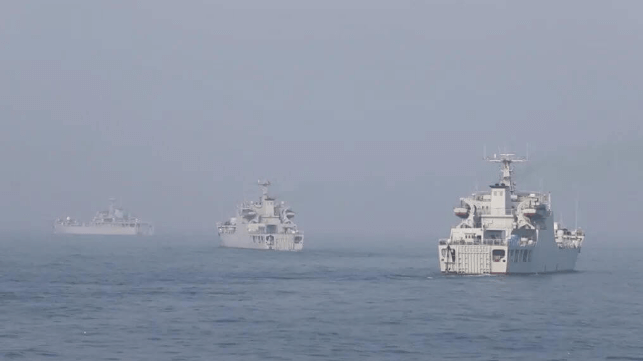
 maritime-executive.com
Image
maritime-executive.com
Image
@IndoPac_Info
#China Conducts Landing Ship Drills as Tensions Rise in #SouthChinaSea
China's navy is conducting amphibious drills in the South China Sea as tensions rise over control of the Philippine exclusive economic zone, over five hundred nautical miles away from the Chinese mainland.
Chinese state television broadcaster CCTV reports that three landing ships - Danxiashan, Laotieshan and Lushan - carried out a four-day combat drill at an undisclosed location in the South China Sea.
The drills focused on search and rescue, live fire, damage control, ship-to-ship mooring, smokescreens, and anti-drone air defense operations - a modern addition reflecting the recent evolution of unmanned aviation.
These small landing ships date to the last generation of PLA Navy shipbuilding, and are intended to deploy small numbers of troops or armored vehicles directly onto the beach.
Danxiashan is a Type 072 tank landing ship, a Cold War-era design with a capacity to deliver up to 10 tanks. The Lushan is a smaller Type 073, capable of carrying five tanks.
Both could be used for direct amphibious landings on reefs, atolls and other contested features in the Spratly Islands, giving China the ability to quickly seize undefended land features in Philippine waters.
Philippines sends message of defiance
Last week, China Coast Guard personnel rammed and assaulted a Philippine resupply mission at Second Thomas Shoal, injuring eight Philippine soldiers and damaging several military RHIBs. One Philippine servicemember lost a thumb in the exchange, and images of Chinese troops wielding axes and knives circulated around the world.
On Sunday, in a visit to the Armed Forces of the Philippines' Western Command headquarters, Philippine President Ferdinand Marcos Jr. said that he was proud of the way that the troops at Second Thomas Shoal responded to China's "intense provocation" with restraint.
"You demonstrated to the world that the Filipino spirit is one that is brave, determined, and yet compassionate," he said.
Marcos emphasized that his administration does not seek war with China, but will not back down when it comes to its internationally-recognized maritime boundaries.
"In defending the nation, we stay true to our Filipino nature that we would like to settle all these issues peacefully. And in the performance of our duties, we will not resort to the use of force or intimidation," Marcos said.
"But at the same time, we stand firm. Our calm and peaceful disposition should not be mistaken for acquiescence. . . . We will never be subjugated and oppressed by anyone."
Marcos presented the 73 troops who were involved in the resupply operation with an award, with special recognition for the servicemember who was injured in the fight.
Though his administration has accused China of violating international law at Second Thomas Shoal, Marcos' ministers appeared to take steps to de-escalate this week.
Though the China Coast Guard boarding personnel carried edged weapons, brandished their armament to threaten Philippine servicemembers, and stole two Philippine RHIBs, National Security Adviser (NSA) Secretary Eduardo Año emphasized that "we cannot classify it as an armed attack."
"By international definition of an armed attack, it is the use of military force, an excessive use of force that could trigger collective self defense," Año said on Monday.

China Conducts Landing Ship Drills as Tensions Rise in S. China Sea
China's navy is conducting amphibious drills in the South China Sea as tensions rise over control of the Philippine exclusive economic zone, ove...
northern watch
TB Fanatic
jward
passin' thru
Indo-Pacific News - Geo-Politics & Defense
@IndoPac_Info
#China increases naval & air presence in the EEZ of the #Philippines
#PLA Navy's Shandong Carrier Strike Group spotted in the South China Sea near the Philippines.
Over the past few days, Chinese aircraft and drones have been operating along virtually all of PH EEZ waters. They take off from air bases in Hainan Island and from bases in the Chinese artificial islands such as Fiery Cross and Subi islands.
In addition, a detachment of Chinese naval warships consisting of two destroyers, one frigate and a support vessel was recently spotted near the Philippine island of Palawan. The waters near Palawan seem to be a new target.
This is in addition to a strong China Coast guard and China maritime militia presence, which is already the new normal, particularly in Second Thomas Shoal, Scarborough Shoal and Sabina Shoal.
View: https://twitter.com/IndoPac_Info/status/1806530274941165750
@IndoPac_Info
#China increases naval & air presence in the EEZ of the #Philippines
#PLA Navy's Shandong Carrier Strike Group spotted in the South China Sea near the Philippines.
Over the past few days, Chinese aircraft and drones have been operating along virtually all of PH EEZ waters. They take off from air bases in Hainan Island and from bases in the Chinese artificial islands such as Fiery Cross and Subi islands.
In addition, a detachment of Chinese naval warships consisting of two destroyers, one frigate and a support vessel was recently spotted near the Philippine island of Palawan. The waters near Palawan seem to be a new target.
This is in addition to a strong China Coast guard and China maritime militia presence, which is already the new normal, particularly in Second Thomas Shoal, Scarborough Shoal and Sabina Shoal.
View: https://twitter.com/IndoPac_Info/status/1806530274941165750
jward
passin' thru
R A W S G L B A L
@RawsGlobal
#UPDATE: "An official at South Korea's Unification Ministry that handles inter-Korean affairs said there were no further comments to give on KCNA's report on "important news."
It's been now over four hours since the KCNA report. Still no word on what time the announcement will be made.
8:31 PM · Jun 29, 2024
15.2K
Views
DivaPatriot
@TeamAmerica2020
Was it this?
DivaPatriot
@TeamAmerica2020
JUST IN - North Korea condemned joint military exercise "Freedom Edge" in the Daryeong region, saying that it's "seriously threatens world peace and stability, and will take offensive and overwhelming countermeasures to protect the nation's sovereignty and security," - State run KCNA announced
The US, Japan and South Korea have launched three days of military drills near the Korean Peninsula. The "Freedom Edge" exercise comes as North Korea ramps up military activity in the region.
View: https://twitter.com/TeamAmerica2020/status/1807196697308606547
R A W S G L B A L
@RawsGlobal
I thought it was, but i haven't see any sources clarify that it was part of the important announcement.
North Korea state media says there is an 'important report' amid key party meeting
SEOUL, June 30 (Reuters) - North Korea's state news agency said in a one-line dispatch on Sunday there was "important news" but did not provide details.
Leader Kim Jong Un is presiding over a key meeting of the ruling party to review the performance of the party in the first half of the year.
In a separate report on Sunday morning following the "important news" dispatch, KCNA news agency said that Kim made a speech on the focus of the second half of the year during the party's gathering and addressed "deviations" hampering stable economic development. KCNA did not provide further details about his speech.
The meeting comes after Kim's recent summit with Russian President Vladimir Putin where the two signed a pact including a pledge of mutual defense if either is attacked.
An official at South Korea's Unification Ministry that handles inter-Korean affairs said there were no further comments to give on KCNA's report on "important news."
Get the latest news and expert analysis about the state of the global economy with Reuters Econ World. Sign up here.
Reporting by Ju-min Park and Hyunsu Yim; Editing by Chizu Nomiyama and Daniel Wallis
Our Standards: The Thomson Reuters Trust Principles., opens new tab
@RawsGlobal
#UPDATE: "An official at South Korea's Unification Ministry that handles inter-Korean affairs said there were no further comments to give on KCNA's report on "important news."
It's been now over four hours since the KCNA report. Still no word on what time the announcement will be made.
8:31 PM · Jun 29, 2024
15.2K
Views
DivaPatriot
@TeamAmerica2020
Was it this?
DivaPatriot
@TeamAmerica2020
JUST IN - North Korea condemned joint military exercise "Freedom Edge" in the Daryeong region, saying that it's "seriously threatens world peace and stability, and will take offensive and overwhelming countermeasures to protect the nation's sovereignty and security," - State run KCNA announced
The US, Japan and South Korea have launched three days of military drills near the Korean Peninsula. The "Freedom Edge" exercise comes as North Korea ramps up military activity in the region.
View: https://twitter.com/TeamAmerica2020/status/1807196697308606547
R A W S G L B A L
@RawsGlobal
I thought it was, but i haven't see any sources clarify that it was part of the important announcement.
North Korea state media says there is an 'important report' amid key party meeting
SEOUL, June 30 (Reuters) - North Korea's state news agency said in a one-line dispatch on Sunday there was "important news" but did not provide details.
Leader Kim Jong Un is presiding over a key meeting of the ruling party to review the performance of the party in the first half of the year.
In a separate report on Sunday morning following the "important news" dispatch, KCNA news agency said that Kim made a speech on the focus of the second half of the year during the party's gathering and addressed "deviations" hampering stable economic development. KCNA did not provide further details about his speech.
The meeting comes after Kim's recent summit with Russian President Vladimir Putin where the two signed a pact including a pledge of mutual defense if either is attacked.
An official at South Korea's Unification Ministry that handles inter-Korean affairs said there were no further comments to give on KCNA's report on "important news."
Get the latest news and expert analysis about the state of the global economy with Reuters Econ World. Sign up here.
Reporting by Ju-min Park and Hyunsu Yim; Editing by Chizu Nomiyama and Daniel Wallis
Our Standards: The Thomson Reuters Trust Principles., opens new tab
The necessity of common defense against China will, indeed, find strange bedfellows. In the eighty years since MacArthur returned to the Philippines, most participants have since died. However, the trauma and injuries to the psyche of their descendants is still there. After the war, the Huks and Viet Minh were also prevalent in creating problems that still exist today. Homogenous? The Philippines are not there yet. With fifth column activities there steadily increasing, along with Chinese support of Philippine Jihadis, it’s going to create a powder keg, perhaps, equal to what which General Pershing had to contend with. The economy, worldwide, sucks, and the Philippines are no different from the rest of the world. China is boil that must, eventually, be lanced.
OA
jward
passin' thru
Clash Report
@clashreport
Big fail: "Static" fire test of Chinese Tianlong-3 medium-lift orbital launch vehicle gone horribly wrong today.
The vehicle has been under development by the Chinese private aerospace manufacturer Space Pioneer.
View: https://twitter.com/clashreport/status/1807351601184625071
@clashreport
Big fail: "Static" fire test of Chinese Tianlong-3 medium-lift orbital launch vehicle gone horribly wrong today.
The vehicle has been under development by the Chinese private aerospace manufacturer Space Pioneer.
View: https://twitter.com/clashreport/status/1807351601184625071
jward
passin' thru
North Korea labels South Korea-U.S.-Japan ties Asia's version of NATO
The Japan Times
Seoul –
North Korea criticized a joint military exercise by South Korea, Japan and the United States held this month, state media said on Sunday, saying such drills show the relationship among three countries has developed into "the Asian version of NATO."
On Thursday, the three countries began large-scale joint military drills called "Freedom Edge" involving navy destroyers, fighter jets and the nuclear-powered U.S. aircraft carrier Theodore Roosevelt, aimed at boosting defenses against missiles, submarines and air attacks.
The exercise was devised at the three-way summit at Camp David last year to strengthen military cooperation amid tensions on the Korean peninsula stemming from North Korea's weapons testing.
Pyongyang will not ignore the strengthening of a military bloc led by the U.S. and its allies and will protect regional peace with an aggressive and overwhelming response, North Korea's foreign ministry said in a statement, according to the official Korean Central News Agency (KCNA).
The ministry also said Washington was continuing its effort to link up South Korea and Japan to NATO, adding South Korea's attempts to supply weapons to Ukraine is one example of that effort.
;)
North Korean leader Kim Jong Un takes part in the second day of a key meeting of the ruling Workers' Party of Korea in this photo released Sunday. | KCNA / KNS / VIA AFP-JIJI
South Korea said it would review the possibility of supplying arms directly to Ukraine, in protest against a recent mutual defense pact signed between North Korean leader Kim Jong Un and Russian President Vladimir Putin.
South Korea and the United States have accused the North of supplying weapons to Russia that are being used in the Ukraine war. Both Russia and North Korea deny any such transactions.
KCNA said in a one-line dispatch on Sunday there was "important news" but did not provide details, amid speculation more details of the North Korea-Russia cooperation could soon be revealed.
An official at South Korea's Unification Ministry that handles inter-Korean affairs said there were no further comments to give on KCNA's report on "important news."
On Saturday, North Korea's ruling party held a key meeting for the second day, presided by Kim, who addressed "deviations" hampering economic development and laid out the focus for the second half of the year, state media said.
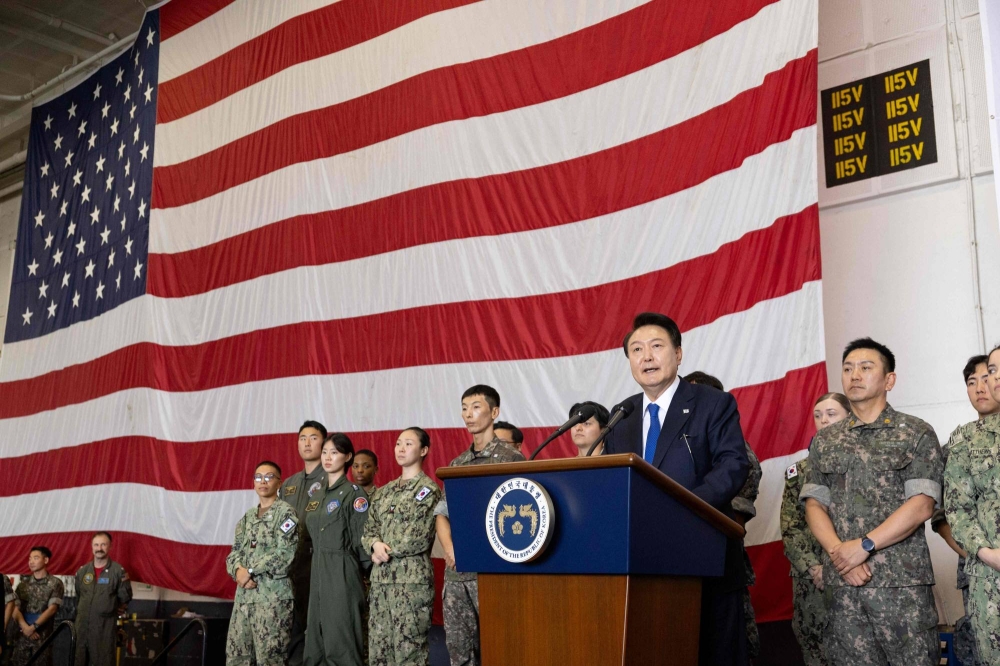
North Korea labels South Korea-U.S.-Japan ties Asia's version of NATO
North Korea criticized a joint military exercise by South Korea, Japan and the United States, which highlighted the three countries' growing security ties.
jward
passin' thru
apnews.com
Updated 5:59 PM CDT, June 30, 2024
SEOUL, South Korea (AP) — North Korea launched at least one short-range ballistic missile off its east coast Monday, South Korea’s military said, a day after the North vowed “offensive and overwhelming” responses to a new U.S. military drill with South Korea and Japan.
The Joint Chiefs of Staff said the missile was launched from North Korea’s southeastern town of Jangyon at 5:05 a.m. It said an additional, unidentified ballistic missile launch trajectory was detected 10 minutes later, a suggestion that North Korea might have performed two missile launches.
The Joint Chiefs of Staff said South Korea’s military has boosted its surveillance posture and is closely exchanging related information with the United States and Japan.
The launch came two days after South Korea, the U.S. and Japan ended their new multidomain trilateral drills in the region. In recent years, the three countries have been expanding their trilateral security partnership to better cope with North Korea’s evolving nuclear threats and China’s increasing assertiveness in the region.
The “Freedom Edge” drill was meant to increase the sophistication of previous exercises with simultaneous air and naval drills geared toward improving joint ballistic-missile defense, anti-submarine warfare, surveillance and other skills and capabilities. The three-day drill involved a U.S. aircraft carrier as well as destroyers, fighter jets and helicopters from the three countries.
On Sunday, North Korea’s Foreign Ministry issued a lengthy statement strongly denouncing the “Freedom Edge” drill, calling it an Asian version of NATO. It said the drill openly destroyed the security environment on the Korean Peninsula and contained a U.S. intention to lay siege to China and exert pressure on Russia.
The statement said North Korea will “firmly defend the sovereignty, security and interests of the state and peace in the region through offensive and overwhelming countermeasures.”
Monday’s launch was the North’s first weapons firing in five days. On Wednesday, North Korea launched what it called a multiwarhead missile in the first known launch of a developmental, advanced weapon meant to defeat U.S. and South Korean missile defenses. North Korea said the launch was successful, but South Korea dismissed the North’s claim as deception to cover up a failed launch.
In recent weeks, North Korea has also floated numerous trash-carrying balloons toward South Korea in what it has described as a tit-for-tat response to South Korean activists sending political leaflets via their own balloons. South Korea responded by briefly resuming its anti-Pyongyang frontline propaganda broadcasts for the first time in years.
In mid-June, North Korean leader Kim Jong Un and Russian President Vladimir Putin struck a deal vowing mutual defense assistance if either is attacked. Observers say the pact could embolden Kim to launch more provocations at South Korea. The U.S., South Korea and others believe Pyongyang has been supplying conventional weapons to Russia for its war against Ukraine in return for military and economic assistance.
Meanwhile, North Korea opened a key ruling party meeting Friday to determine what it called “important, immediate issues” related to works to further enhance Korean-style socialism. On the meeting’s second day, North Korea’s leader spoke about “some deviations obstructing” efforts to improve the country’s economic status and unspecified important tasks for resolving immediate policy issues, North Korea’s state media reported Sunday.https://apnews.com/article/north-korea-ballistic-missile-launch-south-korea-5a247e48cdcd3c8098381a0c038da19d?taid=6681c1ae6190110001ee073f
North Korea launches a ballistic missile toward sea, after end of new US-South Korea-Japan drill
Updated 5:59 PM CDT, June 30, 2024
SEOUL, South Korea (AP) — North Korea launched at least one short-range ballistic missile off its east coast Monday, South Korea’s military said, a day after the North vowed “offensive and overwhelming” responses to a new U.S. military drill with South Korea and Japan.
The Joint Chiefs of Staff said the missile was launched from North Korea’s southeastern town of Jangyon at 5:05 a.m. It said an additional, unidentified ballistic missile launch trajectory was detected 10 minutes later, a suggestion that North Korea might have performed two missile launches.
The Joint Chiefs of Staff said South Korea’s military has boosted its surveillance posture and is closely exchanging related information with the United States and Japan.
The launch came two days after South Korea, the U.S. and Japan ended their new multidomain trilateral drills in the region. In recent years, the three countries have been expanding their trilateral security partnership to better cope with North Korea’s evolving nuclear threats and China’s increasing assertiveness in the region.
The “Freedom Edge” drill was meant to increase the sophistication of previous exercises with simultaneous air and naval drills geared toward improving joint ballistic-missile defense, anti-submarine warfare, surveillance and other skills and capabilities. The three-day drill involved a U.S. aircraft carrier as well as destroyers, fighter jets and helicopters from the three countries.
On Sunday, North Korea’s Foreign Ministry issued a lengthy statement strongly denouncing the “Freedom Edge” drill, calling it an Asian version of NATO. It said the drill openly destroyed the security environment on the Korean Peninsula and contained a U.S. intention to lay siege to China and exert pressure on Russia.
The statement said North Korea will “firmly defend the sovereignty, security and interests of the state and peace in the region through offensive and overwhelming countermeasures.”
Monday’s launch was the North’s first weapons firing in five days. On Wednesday, North Korea launched what it called a multiwarhead missile in the first known launch of a developmental, advanced weapon meant to defeat U.S. and South Korean missile defenses. North Korea said the launch was successful, but South Korea dismissed the North’s claim as deception to cover up a failed launch.
In recent weeks, North Korea has also floated numerous trash-carrying balloons toward South Korea in what it has described as a tit-for-tat response to South Korean activists sending political leaflets via their own balloons. South Korea responded by briefly resuming its anti-Pyongyang frontline propaganda broadcasts for the first time in years.
In mid-June, North Korean leader Kim Jong Un and Russian President Vladimir Putin struck a deal vowing mutual defense assistance if either is attacked. Observers say the pact could embolden Kim to launch more provocations at South Korea. The U.S., South Korea and others believe Pyongyang has been supplying conventional weapons to Russia for its war against Ukraine in return for military and economic assistance.
Meanwhile, North Korea opened a key ruling party meeting Friday to determine what it called “important, immediate issues” related to works to further enhance Korean-style socialism. On the meeting’s second day, North Korea’s leader spoke about “some deviations obstructing” efforts to improve the country’s economic status and unspecified important tasks for resolving immediate policy issues, North Korea’s state media reported Sunday.https://apnews.com/article/north-korea-ballistic-missile-launch-south-korea-5a247e48cdcd3c8098381a0c038da19d?taid=6681c1ae6190110001ee073f
jward
passin' thru
Indo-Pacific News - Geo-Politics & Defense
@IndoPac_Info
#NorthKorea tests 2 missiles, 1 reportedly failed
One of the two launches may have flown toward Pyongyang, Yonhap reported.
North Korea test-launched on Monday two ballistic missiles, one of which may have failed and fallen to the ground before reaching the sea, according to South Korea's military and media.
"We strongly condemn North Korea's missile launch as a clear provocation that seriously threatens peace and stability on the Korean Peninsula," South Korea's Joint Chiefs of Staff said.
The tests were detected at 5:05 a.m. and 5:15 a.m., the South Korean military said. South Korean officials shared the launch data in real-time with the United States and Japan, South Korean Joint Chiefs of Staff said Monday.
The latest provocation from North Korea and its leader, Kim Jong Un, followed last week's joint military exercises by the U.S., Japan and South Korea. Those exercises were a sign that the security cooperation in the region "has never been stronger," U.S. Secretary of Defense Lloyd Austin said on Friday.
The U.S. military condemned Monday's launches, calling on North Korea to put an end to its "unlawful and destabilizing acts."
"While we have assessed that this event does not pose an immediate threat to U.S. personnel, or territory, or to our allies, we continue to monitor the situation," the U.S. Indo-Pacific Command said in a statement. "The U.S. commitments to the defense of the ROK and Japan remain ironclad."
The first of Monday's ballistic missile tests flew about 600 km, or about 373 miles, and landed off Chongjin, North Korea, in the Sea of Japan, the South Korean military said.
The other missile appeared to have flown only about 120 km, or about 75 miles, the military told the South Korean news agency Yonhap.
"It is difficult to know exactly where the short-range missile hit, and we believe it may have gone toward Pyongyang," a South Korean military official said, according to Yonhap.

 abcnews.go.com
abcnews.go.com
@IndoPac_Info
#NorthKorea tests 2 missiles, 1 reportedly failed
One of the two launches may have flown toward Pyongyang, Yonhap reported.
North Korea test-launched on Monday two ballistic missiles, one of which may have failed and fallen to the ground before reaching the sea, according to South Korea's military and media.
"We strongly condemn North Korea's missile launch as a clear provocation that seriously threatens peace and stability on the Korean Peninsula," South Korea's Joint Chiefs of Staff said.
The tests were detected at 5:05 a.m. and 5:15 a.m., the South Korean military said. South Korean officials shared the launch data in real-time with the United States and Japan, South Korean Joint Chiefs of Staff said Monday.
The latest provocation from North Korea and its leader, Kim Jong Un, followed last week's joint military exercises by the U.S., Japan and South Korea. Those exercises were a sign that the security cooperation in the region "has never been stronger," U.S. Secretary of Defense Lloyd Austin said on Friday.
The U.S. military condemned Monday's launches, calling on North Korea to put an end to its "unlawful and destabilizing acts."
"While we have assessed that this event does not pose an immediate threat to U.S. personnel, or territory, or to our allies, we continue to monitor the situation," the U.S. Indo-Pacific Command said in a statement. "The U.S. commitments to the defense of the ROK and Japan remain ironclad."
The first of Monday's ballistic missile tests flew about 600 km, or about 373 miles, and landed off Chongjin, North Korea, in the Sea of Japan, the South Korean military said.
The other missile appeared to have flown only about 120 km, or about 75 miles, the military told the South Korean news agency Yonhap.
"It is difficult to know exactly where the short-range missile hit, and we believe it may have gone toward Pyongyang," a South Korean military official said, according to Yonhap.

ABC News – Breaking News, Latest News and Videos
Get the latest international news and world events from Asia, Europe, the Middle East, and more. See world news photos and videos at ABCNews.com
jward
passin' thru
Jeff Seldin
@jseldin
2h
NEW: #China appears to be operating 4 electronic, signals intelligence sites in #Cuba to spy on the US, per a @CSIS
@HiddenReachCSIS report based on satellite imagery
View: https://twitter.com/jseldin/status/1808157744102277286
@jseldin
2h
NEW: #China appears to be operating 4 electronic, signals intelligence sites in #Cuba to spy on the US, per a @CSIS
@HiddenReachCSIS report based on satellite imagery
View: https://twitter.com/jseldin/status/1808157744102277286
Last edited:
jward
passin' thru
Tal Inbar
@inbarspace
North Korea's latest missile: Hwasong 11-Da 4.5 with 4500 kg warhead (!). No pictures were published (yet?...)
View: https://twitter.com/inbarspace/status/1808040009682780439
@inbarspace
North Korea's latest missile: Hwasong 11-Da 4.5 with 4500 kg warhead (!). No pictures were published (yet?...)
View: https://twitter.com/inbarspace/status/1808040009682780439
jward
passin' thru
Gordon G. Chang
@GordonGChang
As a gesture to ease tensions with #China, the #US is withdrawing a missile-defense system from the #Philippines: Why is the US Typhon missile system being withdrawn from the Philippines?
. Today, however, #Manila announced that the #Chinese anchored a large vessel in #Philippine waters, apparently at #Sabina #Shoal in the #SouthChinaSea.
@GordonGChang
As a gesture to ease tensions with #China, the #US is withdrawing a missile-defense system from the #Philippines: Why is the US Typhon missile system being withdrawn from the Philippines?
. Today, however, #Manila announced that the #Chinese anchored a large vessel in #Philippine waters, apparently at #Sabina #Shoal in the #SouthChinaSea.
jward
passin' thru
Indo-Pacific News - Geo-Politics & Defense
@IndoPac_Info
#Philippines turned down #US help amid sea tensions
"We try to exhaust all possible options that we have before we ask for help."
Some observers, including former deputy US National Security Adviser Matt Pottinger, have called for direct US naval support for the resupply missions.
The Philippines has turned down offers from the United States to assist operations in the South China Sea, after a flare-up with China over missions to resupply Filipino troops on a contested shoal, its military chief said.
Tensions in the disputed waterway have boiled over into violence in the past year, with a Filipino sailor losing a finger in the latest June 17 clash that Manila described as "intentional-high speed ramming" by the Chinese coast guard.
The US, a treaty ally, has offered support but Manila prefers to handle operations on its own, Armed Forces Chief Gen Romeo Brawner told Reuters late Thursday.
"Yes, of course, they have been offering help and they asked us how they could help us in any way," he said.
"We try to exhaust all possible options that we have before we ask for help."
Manila and Washington are bound by the 1951-Mutual Defense Treaty (MDT), a military pact that can be invoked in the case of armed attacks on Philippine forces, public vessels, or aircraft in the South China Sea.
Confrontations between the Philippines and China in Asia's most contested waters have increased in frequency over the past year as Beijing has pressed its claim to the waterway and Manila continued missions to bring supplies to soldiers living aboard a rusty, aging warship that it grounded on a contested shoal.
Some observers, including former deputy US National Security Adviser Matt Pottinger, have called for direct US naval support for the resupply missions.
But Philippine National Security Adviser Eduardo Ano said the Philippines wanted them to be a "pure Philippine operation".
"This is our legitimate national interest, so we don't see any reason for them (the US) to come in," Ano told Reuters.
Ano, who spoke to his US counterpart Jake Sullivan last month to discuss shared concerns over China's "dangerous and escalatory actions", said the MDT was "far from being invoked".
"We (the Philippines and China) agreed that there will be some easing tension, but we will assert our rights, we will not compromise our national interest, and we will continue to fight and claim what is ours," Ano said.
Neither official specified what support the US had offered.
Greg Poling, a South China Sea expert at Washington's Center for Strategic and International Studies think-tank, told Reuters he believed the US was open to naval escorts for the resupply missions to the stranded vessel. Washington has already provided some limited support, he said.
A Philippine official said last year Manila was consulting the US Army Corps of Engineers on how best to stabilise the BRP Sierra Madre, which was grounded on the contested Second Thomas Shoal, Poling said, while US aircraft have been filmed providing overwatch of the ship on multiple occasions.
The Permanent Court of Arbitration in the Hague ruled in 2016 that Beijing's expansive South China Sea claims via its nine-dash line had no basis under international law, but that has not stopped China, which rejects the ruling, from being more assertive in the waterway.
It has deployed coast guard vessels to patrol those areas, alarming the Philippines, rival Southeast Asian claimants and other states operating in the South China Sea, including the US, which is wary about China's growing military power and territorial ambition.
Military chief Brawner said the United States' offer of support, made in discussions at his level, was not a direct response to the June 17 incident but rather a reflection of the enduring military alliance between the two countries.
"It is really because of our being treaty allies, so that offer has been available to us for a long time not just because of the incident," Brawner said.
"But we did not ask them yet because as per the orders of our president we have to rely on ourselves first."
The Pentagon did not immediately respond to a request for comment. Thursday was a federal holiday in Washington for the United States' Independence Day.
While China claims nearly all the South China Sea, a major shipping lane with about US$3 trillion in trade passing through it annually, Vietnam, Taiwan, Malaysia and Brunei also claim parts.
@IndoPac_Info
#Philippines turned down #US help amid sea tensions
"We try to exhaust all possible options that we have before we ask for help."
Some observers, including former deputy US National Security Adviser Matt Pottinger, have called for direct US naval support for the resupply missions.
The Philippines has turned down offers from the United States to assist operations in the South China Sea, after a flare-up with China over missions to resupply Filipino troops on a contested shoal, its military chief said.
Tensions in the disputed waterway have boiled over into violence in the past year, with a Filipino sailor losing a finger in the latest June 17 clash that Manila described as "intentional-high speed ramming" by the Chinese coast guard.
The US, a treaty ally, has offered support but Manila prefers to handle operations on its own, Armed Forces Chief Gen Romeo Brawner told Reuters late Thursday.
"Yes, of course, they have been offering help and they asked us how they could help us in any way," he said.
"We try to exhaust all possible options that we have before we ask for help."
Manila and Washington are bound by the 1951-Mutual Defense Treaty (MDT), a military pact that can be invoked in the case of armed attacks on Philippine forces, public vessels, or aircraft in the South China Sea.
Confrontations between the Philippines and China in Asia's most contested waters have increased in frequency over the past year as Beijing has pressed its claim to the waterway and Manila continued missions to bring supplies to soldiers living aboard a rusty, aging warship that it grounded on a contested shoal.
Some observers, including former deputy US National Security Adviser Matt Pottinger, have called for direct US naval support for the resupply missions.
But Philippine National Security Adviser Eduardo Ano said the Philippines wanted them to be a "pure Philippine operation".
"This is our legitimate national interest, so we don't see any reason for them (the US) to come in," Ano told Reuters.
Ano, who spoke to his US counterpart Jake Sullivan last month to discuss shared concerns over China's "dangerous and escalatory actions", said the MDT was "far from being invoked".
"We (the Philippines and China) agreed that there will be some easing tension, but we will assert our rights, we will not compromise our national interest, and we will continue to fight and claim what is ours," Ano said.
Neither official specified what support the US had offered.
Greg Poling, a South China Sea expert at Washington's Center for Strategic and International Studies think-tank, told Reuters he believed the US was open to naval escorts for the resupply missions to the stranded vessel. Washington has already provided some limited support, he said.
A Philippine official said last year Manila was consulting the US Army Corps of Engineers on how best to stabilise the BRP Sierra Madre, which was grounded on the contested Second Thomas Shoal, Poling said, while US aircraft have been filmed providing overwatch of the ship on multiple occasions.
The Permanent Court of Arbitration in the Hague ruled in 2016 that Beijing's expansive South China Sea claims via its nine-dash line had no basis under international law, but that has not stopped China, which rejects the ruling, from being more assertive in the waterway.
It has deployed coast guard vessels to patrol those areas, alarming the Philippines, rival Southeast Asian claimants and other states operating in the South China Sea, including the US, which is wary about China's growing military power and territorial ambition.
Military chief Brawner said the United States' offer of support, made in discussions at his level, was not a direct response to the June 17 incident but rather a reflection of the enduring military alliance between the two countries.
"It is really because of our being treaty allies, so that offer has been available to us for a long time not just because of the incident," Brawner said.
"But we did not ask them yet because as per the orders of our president we have to rely on ourselves first."
The Pentagon did not immediately respond to a request for comment. Thursday was a federal holiday in Washington for the United States' Independence Day.
While China claims nearly all the South China Sea, a major shipping lane with about US$3 trillion in trade passing through it annually, Vietnam, Taiwan, Malaysia and Brunei also claim parts.
jward
passin' thru
Tristan Nodalo
@TristanNodalo
BREAKING: The Philippines and Japan will sign the Reciprocal Access Agreement (RAA) tomorrow, July 8
Malacañang says President Bongbong Marcos will witness the signing of the PH-Japan security pact.
PLUS INFO: The Philippines will be the 3rd country to have an RAA with Japan, following Australia and the UK.
@newswatchplusph
@TristanNodalo
BREAKING: The Philippines and Japan will sign the Reciprocal Access Agreement (RAA) tomorrow, July 8
Malacañang says President Bongbong Marcos will witness the signing of the PH-Japan security pact.
PLUS INFO: The Philippines will be the 3rd country to have an RAA with Japan, following Australia and the UK.
@newswatchplusph
jward
passin' thru
InsideNK/GeoPolitics
@inside_nk
3h
North Korea have threaten military action against South Korea if the North judges its own sovereignty as violated.
Kim Yo Jong said South Korea's recent military drills near the border between the two nations are an inexcusable and explicit provocation.
@inside_nk
3h
North Korea have threaten military action against South Korea if the North judges its own sovereignty as violated.
Kim Yo Jong said South Korea's recent military drills near the border between the two nations are an inexcusable and explicit provocation.
jward
passin' thru
Ian Ellis
@ianellisjones
2h
China has moved significant firepower & naval assets into the South & East China Seas
For the first time, Beijing conducted drills within the Philippines EEZ & deployed the Shandong carrier group to nearby waters
Premier surface combatants & amphibious warships also underway
View: https://twitter.com/ianellisjones/status/1810343223140954134
@ianellisjones
2h
China has moved significant firepower & naval assets into the South & East China Seas
For the first time, Beijing conducted drills within the Philippines EEZ & deployed the Shandong carrier group to nearby waters
Premier surface combatants & amphibious warships also underway
View: https://twitter.com/ianellisjones/status/1810343223140954134
jward
passin' thru
eh? I need catchin up, am hopelesly behind with the dog and pony show going on w/ D party.I have to wonder if the Philippines has recently bought any jet skis? (Look at the Russo-Ukraine War thread...)
-I'm still trying to find out how Iran's warship sank :: eek face :: and if that lil incident amounts to anything.
northern watch
TB Fanatic
jward
passin' thru
Ken Moriyasu
@kenmoriyasu
·
5h
NATO and its Indo-Pacific partners will launch four new joint projects to deepen cooperation, Jake Sullivan told a gathering of defense industry officials.
The projects will focus on Ukraine, artificial intelligence, disinformation and cybersecurity.
@kenmoriyasu
·
5h
NATO and its Indo-Pacific partners will launch four new joint projects to deepen cooperation, Jake Sullivan told a gathering of defense industry officials.
The projects will focus on Ukraine, artificial intelligence, disinformation and cybersecurity.
jward
passin' thru
INTL - 66 Chinese aircraft surround Taiwan in biggest sortie of year
66 Chinese aircraft surround Taiwan in biggest sortie of year Taiwan’s defence ministry said Thursday it had detected 66 Chinese military aircraft around the island in a 24-hour window, a record-high this year, a day after it said Beijing was conducting exercises in nearby waters. China...
northern watch
TB Fanatic
jward
passin' thru
BRICS News
@BRICSinfo
JUST IN: China says it's conducting new joint military drills with Russia.
China and Russia are conducting joint military exercises in China's southern waters, named Joint Sea-2024. The drills, which began in early July and will last until mid-July, aim to address maritime security threats and maintain global and regional peace.
These exercises come at a time when tensions are high, with NATO leaders recently meeting in Washington to reaffirm support for Ukraine amid Russia's invasion. China and Russia have drawn closer in recent years, touting their friendship as having "no limits".
NATO has accused China of being a "decisive enabler" of Russia's invasion of Ukraine, prompting Beijing to warn NATO against "provoking confrontation". China maintains that it is not a party to the conflict but has been criticized for providing political and economic support to Russia.
The joint China-Russia activities near Japan's territory have raised a "grave concern from the perspective of national security" for Tokyo. The drills are part of Beijing and Moscow's annual plan for military engagement.
The exercises highlight the growing alignment between China and Russia, both of which share hostile relations with NATO.
@BRICSinfo
JUST IN: China says it's conducting new joint military drills with Russia.
China and Russia are conducting joint military exercises in China's southern waters, named Joint Sea-2024. The drills, which began in early July and will last until mid-July, aim to address maritime security threats and maintain global and regional peace.
These exercises come at a time when tensions are high, with NATO leaders recently meeting in Washington to reaffirm support for Ukraine amid Russia's invasion. China and Russia have drawn closer in recent years, touting their friendship as having "no limits".
NATO has accused China of being a "decisive enabler" of Russia's invasion of Ukraine, prompting Beijing to warn NATO against "provoking confrontation". China maintains that it is not a party to the conflict but has been criticized for providing political and economic support to Russia.
The joint China-Russia activities near Japan's territory have raised a "grave concern from the perspective of national security" for Tokyo. The drills are part of Beijing and Moscow's annual plan for military engagement.
The exercises highlight the growing alignment between China and Russia, both of which share hostile relations with NATO.
jward
passin' thru
North Korea threatens to combat NATO’s Asia-Pacific engagement with ‘new force’ | NK News
shreyasreddy
4–5 minutes
In response to Washington Summit Declaration, Pyongyang warns US-led bloc’s globalization will lead to ‘worldwide war’
The U.S. and NATO are “the most serious threat to world peace” after a landmark declaration this week, North Korea claimed, demanding a “new force” to repel potential expansion attempts in Asia.
In a statement carried by the ruling party newspaper Rodong Sinmun on Saturday, the DPRK foreign ministry blamed “collusion” between the U.S. and its Asia-Pacific allies for worsening regional tensions by labeling countries like North Korea as a threat.
“The U.S. moves to expand military blocs are the vicious root causes that seriously threaten regional peace, severely deteriorate the international security environment and spark a global arms race,” a ministry spokesperson said.
As others like Sweden join the alliance and NATO looks to boost cooperation with Asia-Pacific partners, North Korea warned that this “globalization” strategy could incite a “worldwide war.”
In particular, the statement took aim at the Washington Summit Declaration “cooked up” during a meeting between NATO member states and partner nations including South Korea and Japan this week.
“The Ministry of Foreign Affairs of the DPRK strongly condemns and rejects the ‘Washington Summit Declaration,’ which is an illegal document that undermines the legitimate rights of sovereign states, promotes a new Cold War, and incites military confrontation globally.”
The statement also blamed the U.S. and NATO for worsening the security situation in Europe with the bloc’s “reckless eastward expansion policies,” echoing one of Russia’s main talking points justifying its invasion of Ukraine.
As NATO marked its 75th anniversary in Washington, the new declaration affirmed support for Ukraine and highlighted the need to boost the bloc’s “collective defense” of the bloc.
The Washington Summit Declaration condemned North Korea for “fuelling Russia’s war of aggression against Ukraine” by supplying Moscow with artillery shells and ballistic missiles in violation of U.N. sanctions and expressed concern about deepening cooperation between the two countries.
READ MORE: How the specter of North Korea-Russia military ties hung over the NATO summit
The declaration’s focus on combating “global and interconnected” threats adds to growing speculation that NATO is eyeing expansion to the Asia-Pacific region as countries like Russia, China and North Korea step up cooperation.
While some experts have warned that NATO involvement in the region could exacerbate existing tensions and fuel instability, earlier this week the bloc emphasized the importance of cooperation with Australia, Japan, South Korea and New Zealand to deter threats affecting the Asia-Pacific region as well as Europe and the Americas.
On the sidelines of the summit, U.S. President Joe Biden and South Korean President Yoon Suk-yeol also hailed the alliance’s new nuclear guidelines and stressed the need for continued efforts to strengthen deterrence against Pyongyang’s threats and military cooperation with Russia.
North Korea has in the past condemned the U.S. and its allies for potentially moving to create an “Asian version of NATO” and once again warned after this week’s summit that such activities will inevitably lead to a strong response.
“The prevailing situation requires a new force and mode of counteraction to crush the U.S. military bloc expansion, an unprecedented challenge to international peace and stability,” the foreign ministry statement said.
“The Democratic People’s Republic of Korea will never overlook or avoid the looming grave threat but thoroughly deter the aggression and war threat with stronger level of strategic counteraction and defend peace and security in the region and the rest of the world.”
Edited by Arius Derr

 www.nknews.org
www.nknews.org
shreyasreddy
4–5 minutes
In response to Washington Summit Declaration, Pyongyang warns US-led bloc’s globalization will lead to ‘worldwide war’
The U.S. and NATO are “the most serious threat to world peace” after a landmark declaration this week, North Korea claimed, demanding a “new force” to repel potential expansion attempts in Asia.
In a statement carried by the ruling party newspaper Rodong Sinmun on Saturday, the DPRK foreign ministry blamed “collusion” between the U.S. and its Asia-Pacific allies for worsening regional tensions by labeling countries like North Korea as a threat.
“The U.S. moves to expand military blocs are the vicious root causes that seriously threaten regional peace, severely deteriorate the international security environment and spark a global arms race,” a ministry spokesperson said.
As others like Sweden join the alliance and NATO looks to boost cooperation with Asia-Pacific partners, North Korea warned that this “globalization” strategy could incite a “worldwide war.”
In particular, the statement took aim at the Washington Summit Declaration “cooked up” during a meeting between NATO member states and partner nations including South Korea and Japan this week.
“The Ministry of Foreign Affairs of the DPRK strongly condemns and rejects the ‘Washington Summit Declaration,’ which is an illegal document that undermines the legitimate rights of sovereign states, promotes a new Cold War, and incites military confrontation globally.”
The statement also blamed the U.S. and NATO for worsening the security situation in Europe with the bloc’s “reckless eastward expansion policies,” echoing one of Russia’s main talking points justifying its invasion of Ukraine.
As NATO marked its 75th anniversary in Washington, the new declaration affirmed support for Ukraine and highlighted the need to boost the bloc’s “collective defense” of the bloc.
The Washington Summit Declaration condemned North Korea for “fuelling Russia’s war of aggression against Ukraine” by supplying Moscow with artillery shells and ballistic missiles in violation of U.N. sanctions and expressed concern about deepening cooperation between the two countries.
READ MORE: How the specter of North Korea-Russia military ties hung over the NATO summit
The declaration’s focus on combating “global and interconnected” threats adds to growing speculation that NATO is eyeing expansion to the Asia-Pacific region as countries like Russia, China and North Korea step up cooperation.
While some experts have warned that NATO involvement in the region could exacerbate existing tensions and fuel instability, earlier this week the bloc emphasized the importance of cooperation with Australia, Japan, South Korea and New Zealand to deter threats affecting the Asia-Pacific region as well as Europe and the Americas.
On the sidelines of the summit, U.S. President Joe Biden and South Korean President Yoon Suk-yeol also hailed the alliance’s new nuclear guidelines and stressed the need for continued efforts to strengthen deterrence against Pyongyang’s threats and military cooperation with Russia.
North Korea has in the past condemned the U.S. and its allies for potentially moving to create an “Asian version of NATO” and once again warned after this week’s summit that such activities will inevitably lead to a strong response.
“The prevailing situation requires a new force and mode of counteraction to crush the U.S. military bloc expansion, an unprecedented challenge to international peace and stability,” the foreign ministry statement said.
“The Democratic People’s Republic of Korea will never overlook or avoid the looming grave threat but thoroughly deter the aggression and war threat with stronger level of strategic counteraction and defend peace and security in the region and the rest of the world.”
Edited by Arius Derr

North Korea threatens to combat NATO’s Asia-Pacific engagement with ‘new force’ | NK News
The U.S. and NATO are “the most serious threat to world peace” after a landmark declaration this week, North Korea claimed, demanding a “new force” to repel potential expansion attempts in Asia. In a statement carried by the ruling party newspaper Rodong Sinmun on Saturday, the DPRK foreign...
jward
passin' thru
Clash Report
@clashreport
Trump's running mate J.D. Vance argues that the U.S. does not have the industrial capacity to support wars in Ukraine, Israel, and a potential conflict with China over Taiwan.
— He says "America has to pick and choose" where to focus its resources.
— Vance warns that if China were to invade and take control of Taiwan, it would cause a "Great Depression" in the U.S. due to Taiwan's dominance in computer chip manufacturing that the American economy relies on.
— To prevent this, Vance says the U.S. needs to ramp up domestic manufacturing of military hardware and become "self-sufficient" rather than relying on Taiwan.
— He believes the U.S. should focus on containing China rather than getting overstretched in Europe.
— Vance criticizes those who want the U.S. to provide "limitless resources" to Ukraine, arguing that the Europeans should take more responsibility for their own defense against Russia so America can concentrate on the China threat.
@clashreport
Trump's running mate J.D. Vance argues that the U.S. does not have the industrial capacity to support wars in Ukraine, Israel, and a potential conflict with China over Taiwan.
— He says "America has to pick and choose" where to focus its resources.
— Vance warns that if China were to invade and take control of Taiwan, it would cause a "Great Depression" in the U.S. due to Taiwan's dominance in computer chip manufacturing that the American economy relies on.
— To prevent this, Vance says the U.S. needs to ramp up domestic manufacturing of military hardware and become "self-sufficient" rather than relying on Taiwan.
— He believes the U.S. should focus on containing China rather than getting overstretched in Europe.
— Vance criticizes those who want the U.S. to provide "limitless resources" to Ukraine, arguing that the Europeans should take more responsibility for their own defense against Russia so America can concentrate on the China threat.
jward
passin' thru
Indo-Pacific News - Geo-Politics & Defense
@IndoPac_Info
The #Philippines said that the Typhon US mid-range missile system will be withdrawn from the Philippines by September as a “gesture” to ease tensions with Beijing in the disputed #SouthChinaSea
I don't think such “gesture” will have the desired effect at a time when China is most aggressive in the EEZ of the Philippines. It's most likely to be seen as a sign of weakness.
The Typhon system was deployed in PH for the RIMPAC 2024 exercises but the system could still be redeployed back to the region in the future if needed.
The Typhon system can fire Tomahawk & SM-6 missiles. Tomahawks to attack land targets & SM-6 missiles for air defense.
"Colonel Louie Dema-ala, a Philippine Army spokesman, said the Typhon weapons system deployed in his country would return to the United States in September “as per plan” once other defence equipment used during joint exercises with the US military had been shipped back."
View: https://twitter.com/IndoPac_Info/status/1812840046950863075
@IndoPac_Info
The #Philippines said that the Typhon US mid-range missile system will be withdrawn from the Philippines by September as a “gesture” to ease tensions with Beijing in the disputed #SouthChinaSea
I don't think such “gesture” will have the desired effect at a time when China is most aggressive in the EEZ of the Philippines. It's most likely to be seen as a sign of weakness.
The Typhon system was deployed in PH for the RIMPAC 2024 exercises but the system could still be redeployed back to the region in the future if needed.
The Typhon system can fire Tomahawk & SM-6 missiles. Tomahawks to attack land targets & SM-6 missiles for air defense.
"Colonel Louie Dema-ala, a Philippine Army spokesman, said the Typhon weapons system deployed in his country would return to the United States in September “as per plan” once other defence equipment used during joint exercises with the US military had been shipped back."
View: https://twitter.com/IndoPac_Info/status/1812840046950863075
Jack Straw
@JackStr42679640
6h
Pending more confirmation!
Xi Jinping just had a stroke at CCP’s Third Plenary Session?
Since yesterday, Chinese social media has been buzzing with the news that something 'big' has happened.
Hummm....

